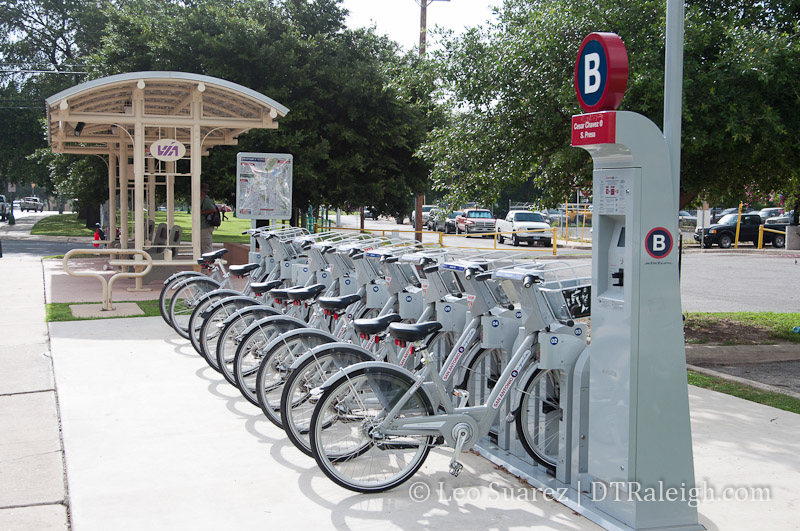
San Antonio B Cycle Station
Or will do anyway according to a recent report. I just went through most of the recently released 2014 Raleigh Bike Share Feasibility Study. The conclusion of the study finds that a bike share system in Raleigh is feasible. You can get the study here (pdf) or see it and a lot of other Bike Raleigh information at BikeRaleigh.org.
I decided to go through the study and take some notes.
Executive Summary
If anything, the Executive Summary is worth reading through. At a high level, the study identifies the following benefits of a bike share system for Raleigh:
- “Augmenting the City’s existing transportation options while encouraging active transportation by lowering barriers to entry for minority and low income residents.”
- “Providing an impetus for further investment in bicycle-friendly facilities.”
- “Building on the City’s reputation as a forward-thinking, bicycle-friendly community.”
- “Using bike share to promote the City to potential employers, residents, and visitors.”
These findings were based on certain qualities that our city has. This includes a comparatively “high resident density” and “high concentration of employers” near downtown, a “significant tourist market,” and “plans and policies in place focusing on the promotion of livable, walkable, and bicycle friendly places.”
A bike share system in Raleigh is not without its challenges however. Two major obstacles identified are:
- “A high dependency on single-occupancy vehicles (SOV’s)”
- “an emerging but not yet complete network of bicycle-friendly facilities”
Also mentioned as obstacles are a “difficult topography” and “existing development patterns” that promote low population and employment densities outside of downtown.
The first round of cost estimates are mentioned as well. From the report, here’s a table showing approximate startup and operating costs based on national averages.
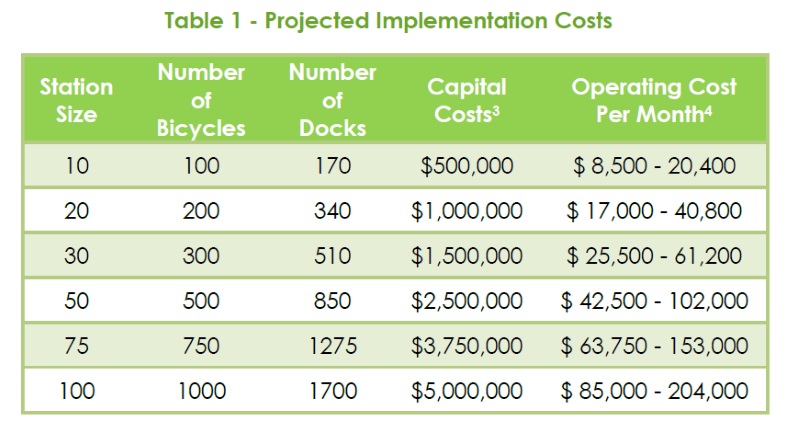
Diving Into The Study
The study is divided into nine sections that start by introducing bike share, what it is and how it has been implemented in other cities, all the way to demand analysis in Raleigh and a final recommendation.
If you are asking yourself, “What is Bike Share?” then I recommend reading pages 4-11 for some background history and fun facts about the service. For example, did you know:
A bike share system can help a community attract and retain residents. Many communities have used bike share systems as an added effort to help (re)vitalize and reactivate their downtown area(s). In addition, it provides a new and different way for tourists to see a city, helping attract more tourists and their spending power to communities.
*2014 Raleigh Bike Share Feasibility Study – Community Economic Benefits page 8
I won’t go over the basics and benefits of a bike share system in this post. Instead, I’ll recommend checking out the study or reading a June 2013 blog post about my visit to San Antonio and using their bike share system.
Community Analysis
The study starts by taking a look at Raleigh and some of the community features like demographics, physical makeup, and current infrastructure.
Our temperate weather is always listed as a plus. Another plus are some generally flat areas around the core downtown. That’s not to say there aren’t some hills out there. I know Glenwood South is on quite a slant when cycling up and down it.
Our population:
The City of Raleigh is the second most populous city in the state with approximately 423,000 people living in the city – a density of around 2,800 people per square mile, which is higher than all of the other southeastern bike share cities.
*2014 Raleigh Bike Share Feasibility Study – Demographics page 26
That’s a pretty powerful statistic right there. Here is the comparison between us and other southeastern bike share cities.

The study shows that the population and employment density is most clustered in and around downtown. There are a few pockets of higher density residential in southwest and north Raleigh but downtown really commands the most attention. See the figure below for a heat map of population density in Raleigh.
Analysis was also done on low-income and minority communities. There is a significant overlap between feasible areas for bike share and locations of these communities. This presents an opportunity to provide a low-cost transit option to these residents.
Compliment to Transit?
Here’s probably the biggest challenge and detractor to the feasibility of a bike share system in Raleigh.
Raleigh is still a predominately auto-oriented city – single occupancy vehicle use represents 79-percent of all commuting trips (See Figure 21).98 Parking costs have traditionally also encouraged vehicle travel, even for short trips.
*2014 Raleigh Bike Share Feasibility Study – Transportation Mode Share page 32
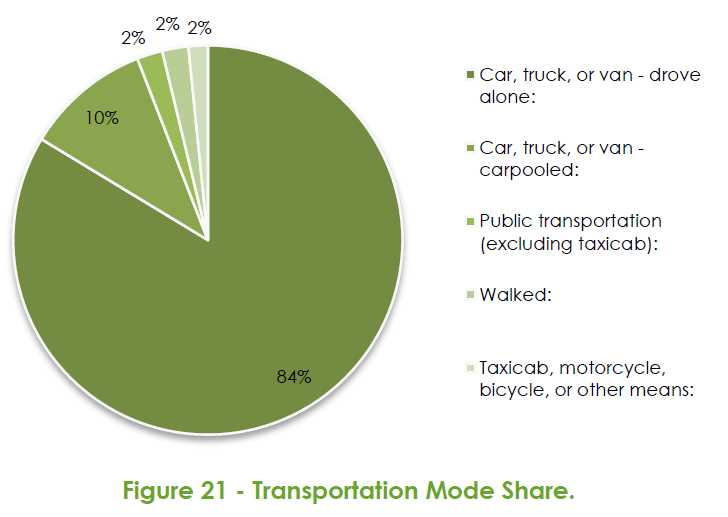
The quote says 79% while the pie chart shows 84%. Unless I’m missing something that might be a typo in the study. Either way, both numbers are pretty high and significantly show Raleigh’s dependency on SOVs.
The only area in the city with a significant amount of proximity to transit, mass transit specifically like Capital Area Transit (CAT), is in downtown. The study points this out as a challenge but lists an opportunity to use bike share to bridge gaps between activity centers that are poorly served by buses.
I think this is the biggest challenge by far for a successful implementation of bike share in Raleigh.
In addition to bus transit, our current bicycle facilities are mentioned. The study recognizes the increase in facilities over the last four years and the city’s commitment to be a “bicycle friendly community.”
However, if you look at the overlap between the areas where bike share is feasible, mainly downtown, and the fact that bike facilities are spread across the city, this leaves much fewer miles to be used within a possible system.
Here’s a point for more discussion. Most bike facilities are actually outside of downtown so to say that bike share can only happen near bike facilities doesn’t quite tell the whole story in my opinion. Downtown streets are naturally friendlier to bicycles so therefore are more fit for bike share. The study points out that there are much less bicycle facilities in downtown as a detriment to a bike share system and I think that could be argued against.
Policy
I’m not going to get into the details of this section but wanted to mention it as I thought it interesting. An identified challenge was that “The permitting process may be complicated due to restrictions on outdoor advertising, historic district designation, right-of-way ownership by multiple government agencies, and specific streetscape plans.”
Complicated indeed. An included flow-chart shows some situations having to go through seven layers of permitting.
Public Engagement
The feasibility study was not without its opportunity for you and I to participate. “Public feedback was gathered using a number of tools including a community workshop, a project website, an online survey, a crowdsourcing map, and interviews with local stakeholders and agencies.”
Surveys showed that 84% of respondents support a bike share program in Raleigh. Opinions, both supportive and of concern, were around the themes of:
- “Promoting bicycling as a viable transportation option in Raleigh.”
- “Helping to reduce traffic congestion.”
- “Helping to make Raleigh an “attractive” city for new residents.”
- “Concern for the cost of the system.”
- “Needing a more extensive bicycle network prior to implementation.”
To gather more information, an online crowdsourcing map was built so that people could suggest station locations and provide comments. Here’s a map of the 151 stations that were received including a table of the top 10.
Big Picture Conclusion
The study goes on to explain its methodology behind the recommendations and results as well differences between the types of bike share systems that are out there. Below is a potential bike share heat map as well as a list with final conclusions and recommendations.
- Geography, Climate and Land Use – “Challenges do not outweigh the opportunities.”
- Demographics and Employment – “Although there are large areas of the City with low population and employment densities, the constant influx of large employers and residents to downtown provide a strong opportunity for successful implementation of a bike share program in the area.”
- Transportation Mode Share – “Coordination of deployment of stations with existing and planned public transportation services will be important to help extend the reach of service and connectivity to and from activity centers.”
- Bicycle Infrastructure – “City should continue to develop its planned network of bicycle facilities and a complete way-finding program in parallel with a potential implementation of a bike share program.”
- Tourism – “City should consider allocating some funding for specialized outreach for tourist oriented promotion of the bike share program.”
- Local and Regional Plans and Policies – “It is recommended that the City review and consider amending local regulations related to signage to allow for the placement of sponsorship and/or advertising on bike share stations to potentially help cover costs for program.”
- Public Input and Stakeholder Engagement – “There is general support for implementing a bike share program in the City of Raleigh. Station based system is preferred.”
Similar Posts:
- Council Discusses Bikeshare in Raleigh | August 28, 2017
- Video: Bikeshare in Raleigh | November 10, 2021
- Municipography, Food Trucks and Raleigh Bikeshare | August 28, 2017
Comments
Comments are disabled here. That's because we're all hanging out on the DTRaleigh Community, an online forum for passionate fans of the Oak City.

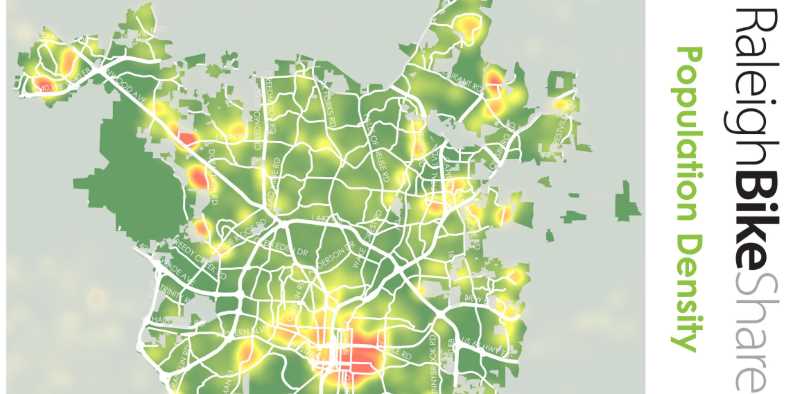
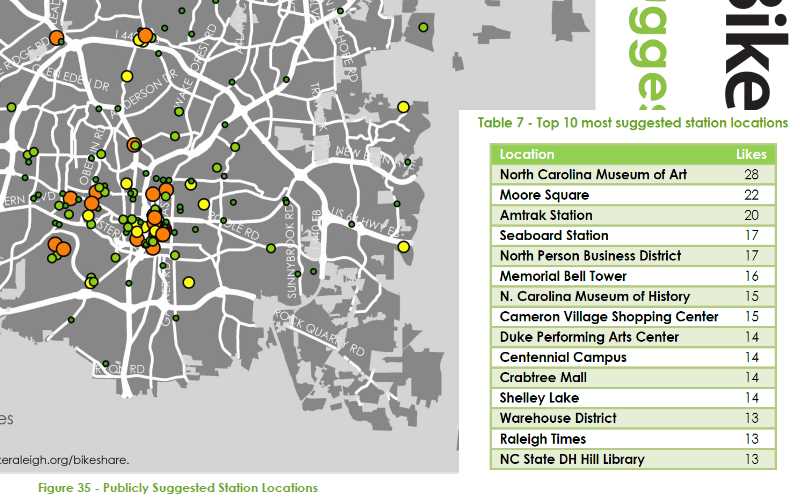
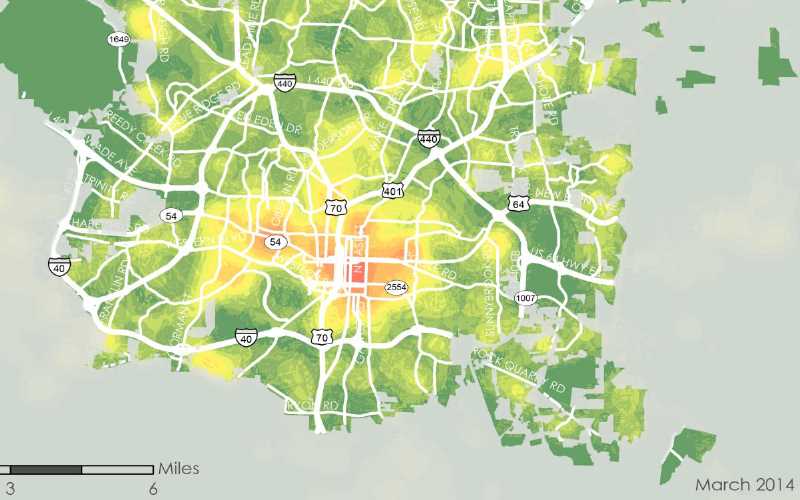
All I know is, if Fort Lauderdale has a bike sharing program, Raleigh definitely deserves one. There was a news article that came out in April about people using the bikes (not renting them) to exercise. The secret…pedaling backwards while it’s still locked in the station.
http://articles.sun-sentinel.com/2014-04-14/news/fl-bcycle-exercise-bike-20140414_1_bikes-pedal-backwards-power-pedalers
Terrible.
Ft. Lauderdale’s system is not South Florida’s successful bikeshare program. That honor belongs to Miami Beach. Its system is much denser and more highly utilized than the one in Ft. Lauderdale. I use it all time and it’s awesome.
Thanks so much for sharing this information Leo!!!!
Thanks for summarizing and consolidating the findings from the study. I hope that the bike share program is implemented in Raleigh soon!
too much $$ for little impact. http://online.wsj.com/articles/city-bike-sharing-programs-hit-speed-bumps-1404959467?KEYWORDS=bike+share
well let’s learn from their mistakes, not just walk away (no pun intended)
I think the most shocking thing I’ve read today is that Spartanburg has a bike share program.
Agree with Matt Gray. I had to read it twice. Anybody who has been to Spartanburg would be shocked by this.
Savannah was left off that list. I don’t think they have an extensive network but they do have bike share stations.
It may not matter. The moronic GOP in the NC legislature is trying to push through a bill that forces cities to ‘choose’ between tax raises for education OR transit.
Education will win every time in a situation like this. When asked why you can’t raise taxes for both…….’crikets’ is what you hear from the GOP. no surprise Paul Coble, aka Mr. NO to everything progressive gets off the hook for holding a voter referendum this fall under a scenario such as this…
I swear the NC GOP’s goal is to take North Carolina back to 1954……..maybe farther than that
More like 1861….
Bikeshare would be great for Raleigh, with Downtown, NC State and the Neuse River Trail being good places to start. The same can be said for the American Tobacco Trail and other campuses.
Uncle Jesse. It’s easy to see what is happening. Pit progressives against each other. It’s a simple divide and conquer strategy that works often enough for it to be used again and again and again. Survival instincts take over more times than not and people throw their friends under the bus. This way the real evil doers don’t have to take the blame.
Couldn’t people just steal them and then sell them off for like 40 dollars or something?
Okay so not supporting bike share program equals evildoer. Gotcha.
Too much Mt. Dew at 2:00 am?
@David…No, not too much Mountain Dew at 2:00 AM. My comment about progressives being pit against each other with a vote is bigger than “not supporting bike share program…”
If you read the other comments, you will see that the vote forces citizens to choose between education and transit issues in general. Knowing that citizens will almost always vote for education first, they wipe their hands clean of killing transit opportunities. Of course, citizens are not being allowed to choose both.
In general and back to topic, these systems only work where the stations are provided densely in close proximity to each other. The reason why Miami Beach’s system works is that there are stations nearly everywhere in SouthBeach and that its convenience allows users to grab one easily where they are likely to find themselves.
What worries me about the destinations that people chose as their top picks is that they are way too scattered for an initial rollout. Frankly speaking, the NCMoA and Crabtree should be off the table for now. The city needs to concentrate on the core of Raleigh first. I can see moving a mile east or a mile west of DT but not much further or the system will find itself underutilized. Based on my experience using a successful system, the initial launch in Raleigh should be as compact and robust as possible to encourage and enable its use. All the DT districts should be serviced as should NC State/St Mary’s (Hillsborough St.), St. Augustine’s, Cameron Village, Chavis Park and Pullen Park. Shaw and Peace are already DT proper so they’re covered.
Once the system has its footing, it can then branch out to other adjacent areas such as Five Points, Centennial Campus, etc. Particular attention should be paid to nodes of high density housing where many users can be captured in a single location. An example of this would be Tucker Street between Boylan and St. Mary’s where hundreds of urban apartments are located with many hundreds more within a block or two.